Abstract.
Technetium-99m mercaptoacetylglycine (99mTc-MAG3) renography is a successful non-invasive method for the evaluation of renal transplants. In this study we prospectively studied 256 patients after renal transplantation, using the MAG3 uptake capacity in the first 10 min (MUC10), which is an index of renal function representing kidney activity as a fraction of the injected dose. Renal scintigraphy was performed in all patients within 48 h of transplantation. Renograms were obtained over 20 min, after bolus injection of ±100 MBq 99mTc-MAG3. MUC10 ranged between 0.0 and 94.9. The patients were divided into five groups: group 1, MUC10 <1; group 2, 1≤MUC10<5; group 3, 5≤MUC10<10; group 4, 10≤MUC10<30; group 5, MUC10 ≥30. In 235 patients, follow-up for 5 years was completed. Considering all the renal transplants, 30% of the grafts ceased functioning within the first 5 years. Six grafts showed a MUC10 of <1, and none survived the first year. After 5 years, 43% of the grafts with a MUC10 of 1–5 still functioned, as compared with 63% of those with a MUC10 of 5–10, 72% of those with a MUC10 of 10–30 and 83% of those with a MUC10 of ≥30. Kaplan-Meier survival analysis showed significant differences between the five different patient groups based on MUC10 in terms of the percentage of kidneys that ceased to function within 5 years. The period of cold ischaemia and the donor age were known in 178 patients. In contrast to cold ischaemia time, the MUC10 and the donor age showed a significant effect (P<0.05) on graft survival. This study indicates that the MUC10 early after renal transplantation is useful as a prognostic factor in the evaluation of kidney transplants and that a MUC10 of <1 indicates a dismal prognosis for the renal transplant.
Similar content being viewed by others
Author information
Authors and Affiliations
Additional information
Received 25 April and in revised form 18 July 2001
Electronic Publication
Rights and permissions
About this article
Cite this article
Stevens, H., Klerk, J.M., Mertens, I.J. et al. Quantitative baseline renography 48 hours after renal transplantation predicts long-term graft survival. Eur J Nucl Med 28, 1677–1681 (2001). https://doi.org/10.1007/s002590100650
Published:
Issue Date:
DOI: https://doi.org/10.1007/s002590100650




